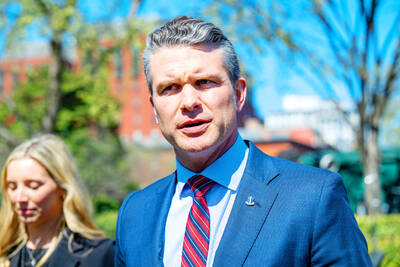A new US military study concluded that the massive missile force China has aimed at Taiwan is being constantly enhanced and improved.
While the actual number of missiles may not have increased much over the past few years — there are believed to be about 1,600 in total — China is introducing newer missiles with better range, accuracy and warheads.
“It [China] has fielded a large, diverse array of increasingly capable short range ballistic missiles, particularly within range of Taiwan,” the report by US Naval War College associate professor Andrew Erickson and senior RAND Corp political scientist Michael Chase said.
Published in this month’s National Interest, the report argues that China’s efforts to undermine Japan’s administrative control over the disputed Diaoyutai Islands (釣魚台列嶼), which Japan calls the Senkaku Islands and Taiwan also claims, are raising the possibility of a crisis that could draw in the US by challenging the credibility of the US’ extended deterrence.
“To deter negative Chinese actions in this vital but volatile region while avoiding dangerous escalation, Washington must better understand the ultimate instrument of Chinese deterrence: the People’s Liberation Army Second Artillery Force [PLASAF], which controls the country’s land-based nuclear and conventional ballistic missiles and its ... land-attack cruise missiles,” the report said.
Possessing the world’s second-largest economy and a growing defense budget has enabled China to deploy more formidable military capabilities, Erickson and Chase said.
They said that Beijing wants to wield these capabilities to increase its leverage in disputes regarding island and maritime intervention “in the event of a conflict with one of its neighbors.”
The PLASAF’s ballistic missile development program has produced longer-range, more accurate, improved-payload missiles to upgrade its existing arsenal.
“China’s missile force has deployed a variety of systems, including short-range ballistic missiles opposite Taiwan, mobile conventionally armed medium-range ballistic missiles for regional deterrence and conventional-strike operations, and new mobile, nuclear-armed ICBMs for strategic deterrence,” the report said.
The report said that to increase its influence over disputed territorial and maritime claims around its contested periphery in peacetime and, if necessary, through wartime operations, China has developed and deployed the world’s foremost force of theater ballistic missiles.
At the theater level, China’s missile force is capable of supporting a variety of types of campaigns against Taiwan, the report said.
The report cites a US Department of Defense finding that China probably could not now enforce a full military blockade, particularly if a major naval power intervened, but its ability to do so would “improve significantly” within 10 years.

‘DENIAL DEFENSE’: The US would increase its military presence with uncrewed ships, and submarines, while boosting defense in the Indo-Pacific, a Pete Hegseth memo said The US is reorienting its military strategy to focus primarily on deterring a potential Chinese invasion of Taiwan, a memo signed by US Secretary of Defense Pete Hegseth showed. The memo also called on Taiwan to increase its defense spending. The document, known as the “Interim National Defense Strategic Guidance,” was distributed this month and detailed the national defense plans of US President Donald Trump’s administration, an article in the Washington Post said on Saturday. It outlines how the US can prepare for a potential war with China and defend itself from threats in the “near abroad,” including Greenland and the Panama

A wild live dugong was found in Taiwan for the first time in 88 years, after it was accidentally caught by a fisher’s net on Tuesday in Yilan County’s Fenniaolin (粉鳥林). This is the first sighting of the species in Taiwan since 1937, having already been considered “extinct” in the country and considered as “vulnerable” by the International Union for Conservation of Nature. A fisher surnamed Chen (陳) went to Fenniaolin to collect the fish in his netting, but instead caught a 3m long, 500kg dugong. The fisher released the animal back into the wild, not realizing it was an endangered species at

The High Prosecutors’ Office yesterday withdrew an appeal against the acquittal of a former bank manager 22 years after his death, marking Taiwan’s first instance of prosecutors rendering posthumous justice to a wrongfully convicted defendant. Chu Ching-en (諸慶恩) — formerly a manager at the Taipei branch of BNP Paribas — was in 1999 accused by Weng Mao-chung (翁茂鍾), then-president of Chia Her Industrial Co, of forging a request for a fixed deposit of US$10 million by I-Hwa Industrial Co, a subsidiary of Chia Her, which was used as collateral. Chu was ruled not guilty in the first trial, but was found guilty

The Chinese Nationalist Party (KMT) is maintaining close ties with Beijing, the Democratic Progressive Party (DPP) said yesterday, hours after a new round of Chinese military drills in the Taiwan Strait began. Political parties in a democracy have a responsibility to be loyal to the nation and defend its sovereignty, DPP spokesman Justin Wu (吳崢) told a news conference in Taipei. His comments came hours after Beijing announced via Chinese state media that the Chinese People’s Liberation Army’s Eastern Theater Command was holding large-scale drills simulating a multi-pronged attack on Taiwan. Contrary to the KMT’s claims that it is staunchly anti-communist, KMT Deputy